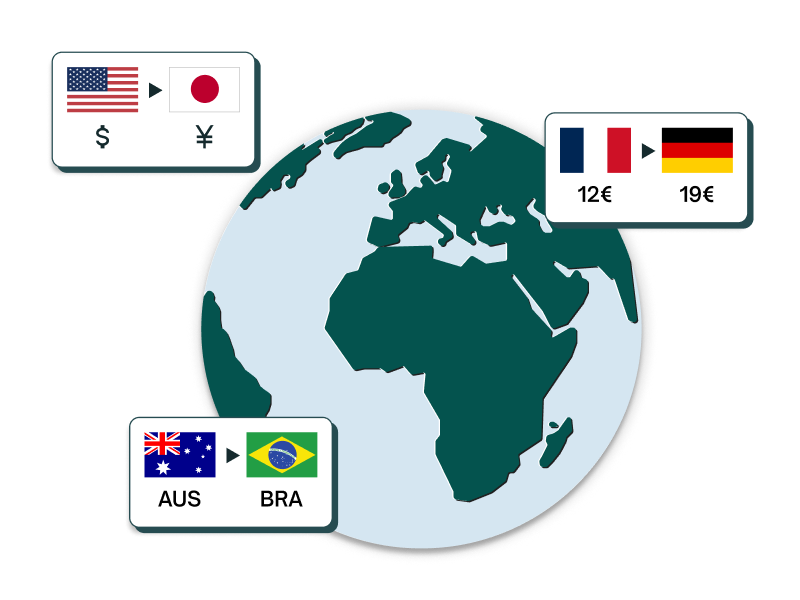What is Shopify Markets: A Comprehensive Guide to Features and Challenges
Understand all you can do on Shopify Markets to get the full advantage for your international sales.

Shopify Markets, introduced in August 2021, is a transformative initiative by Shopify designed to revolutionize cross-border commerce. This comprehensive suite of tools focuses on localizing shopping experiences and improving global sales, offering businesses a seamless pathway to navigate international markets. By prioritizing localization, Shopify Markets recognizes that it is the key to making a store accessible and appealing to locals in new markets.
The localization process within Shopify Markets is holistic, encompassing content translation, cultural adaptation, layout adjustments for diverse languages, establishment of international domains, and customization of every facet of the customer journey. This meticulous approach allows businesses to create a tailored experience that resonates with customers in their target markets.
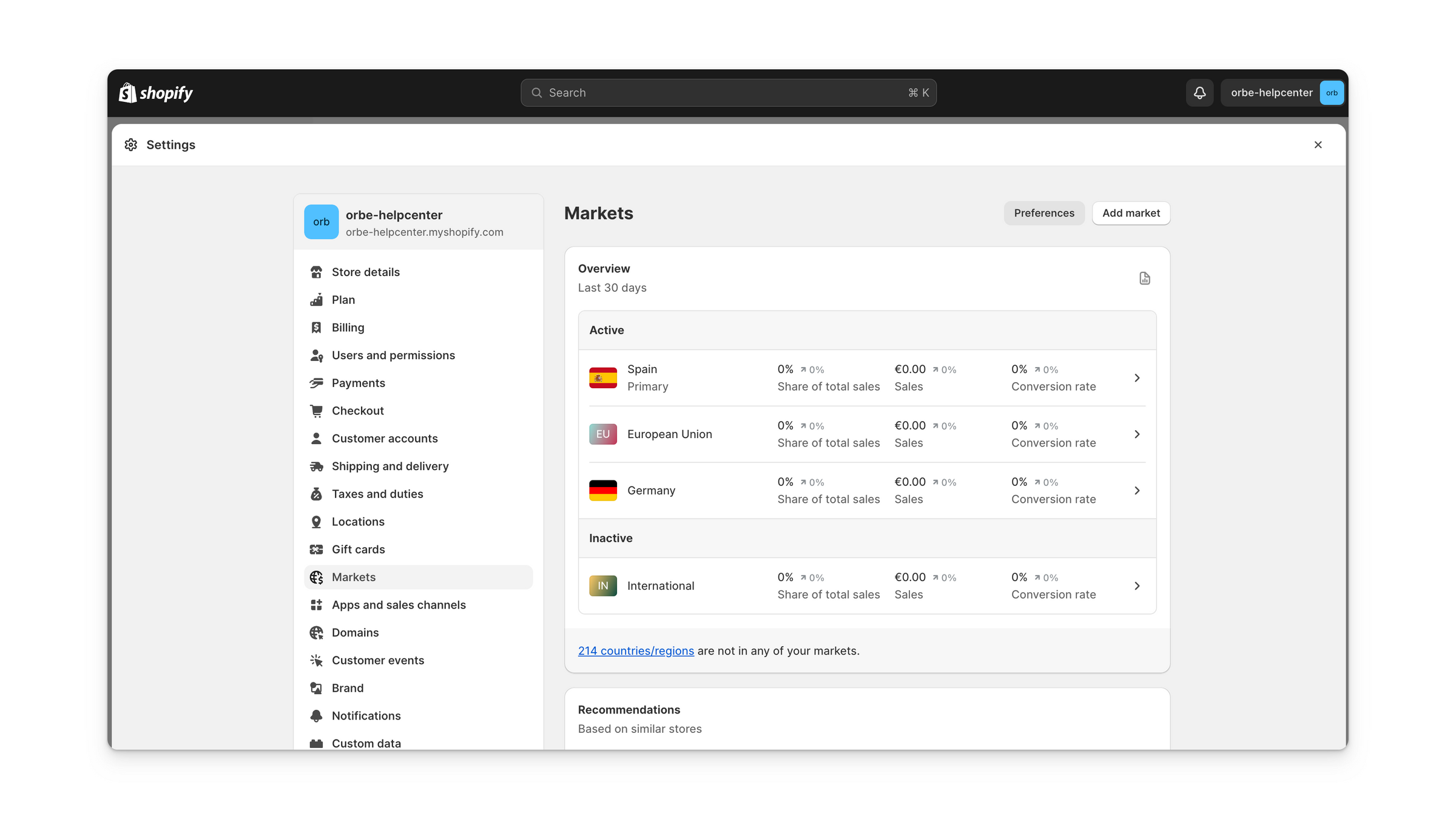
Notably, Shopify Markets stands out as a strategic alternative to Shopify Plus Expansion Stores, simplifying the international expansion journey for businesses. Additionally, features such as local currency integration through Shopify Payments are pivotal in boosting the global conversion rate.
In essence, Shopify Markets stands as a powerful asset for businesses seeking not only to navigate the complexities of international e-commerce but also to excel by providing localized and resonant shopping experiences on a global scale.
In this article, we will delve into the features and limitations of Shopify Markets, share valuable tips, and introduce our course dedicated to teaching you how to set up Shopify Markets effectively. Our goal is to provide you with valuable insights that can bring significant value to both you and your brand. Let's embark on this exploration together.
Shopify Markets Features
Shopify Markets presents significant advantages for businesses eyeing global expansion. One key benefit is streamlined operations—no need to duplicate products or content across multiple stores. You can efficiently manage your global site from a single store. Additionally, Shopify Markets is designed for rapid implementation and launch, simplifying the management of complex operations and enhancing overall consistency.
Ready to delve into the specifics? Let's explore the key features that Shopify Markets offers to facilitate and elevate your global business strategy.
Group Countries within Shopify Markets
Imagine that your brand positioning in different markets is similar across various regions. For instance, your strategy and positioning in Europe, the United Kingdom, Australia, and the United States may be different, while you have limited sales in the rest of the countries. In this case, Shopify Markets allows you to group countries into markets with similar characteristics: same products, same prices, same communication, etc. This streamlines the management and design of shopping experiences.
In Shopify Markets, it doesn't make sense to create a market for every country where you sell. On the contrary, countries should be grouped for better operational management. That's why it's always recommended to have a market named "International" or "Rest of the World" where you add countries that are not relevant to the brand, and where the positioning strategy is standardized.
Local Currency in Shopify Markets
One of the great advantages of Shopify Markets is that, in countries where Shopify Payments is available, brands can allow their customers to make purchases in their respective local currencies, while the brands receive payments in their primary currency. In exchange for a fee for the exchange rate, this practice eliminates any friction, builds trust among end customers, and ultimately boosts international conversion rates. Therefore, Shopify Markets makes your store multi-currency.
If you want to learn more about the countries that allow activating payments in local currency with Shopify Payments, we recommend checking the following article in the Shopify Help Center. Activating this option is simple; just go to the market where you want to implement payments in local currency and check the box 'Show prices to customers in their local currency.'
Imagine, for example, that you are a Spanish brand with the Euro as your primary currency. By activating this option in your markets, you allow your customers in the United States to pay in USD and those in the United Kingdom to pay in GBP.
Different Product and Prices per Market
When expanding internationally, brands, whether for business or operational strategies, often choose to offer specific products or prices in different regions. Shopify Markets effectively addresses this need by providing various options to adjust prices and manage product availability easily in different regions.
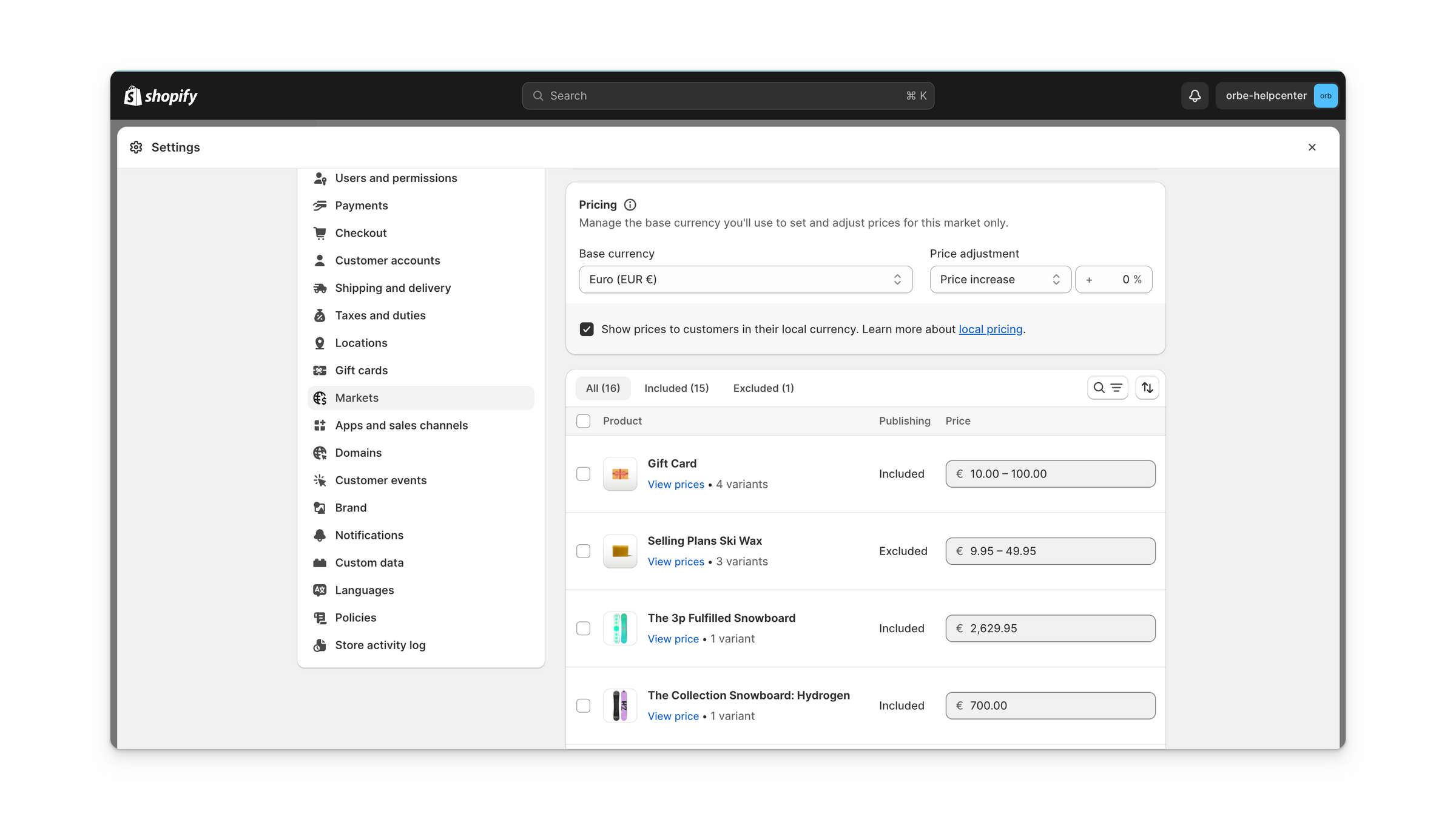
Shopify Markets Languages
Optimizing international sales involves translating your store into different languages, and you can achieve this easily using various applications such as Shopify Translate & Adapt or Langify. With Shopify Markets, you can configure the available languages for each market. As a best practice for SEO, we advise against making all languages accessible in every market to avoid unnecessary crawl budget expenditure.
Crawl budget refers to the limit or allocation of resources that a search engine, like Google, assigns to crawl and index web pages on a website. Consequently, if this budget is spent on indexing non-relevant pages, it reduces the resources available for indexing the relevant ones.
Therefore, when considering a relevant market like France and having Spanish as an available language in the store, it's worth questioning whether it makes sense for our French users to be able to shop in Spanish. At Orbe, we recommend against it.
Adapt Content per Market in Shopify Markets
Starting from July 2023, with the release of Shopify Summer Editions, it is now possible to customize the homepage of stores and various sections to display different content (messages, products, collections, etc.) based on the market. This update marks a significant advancement in adapting the brand to different regions.
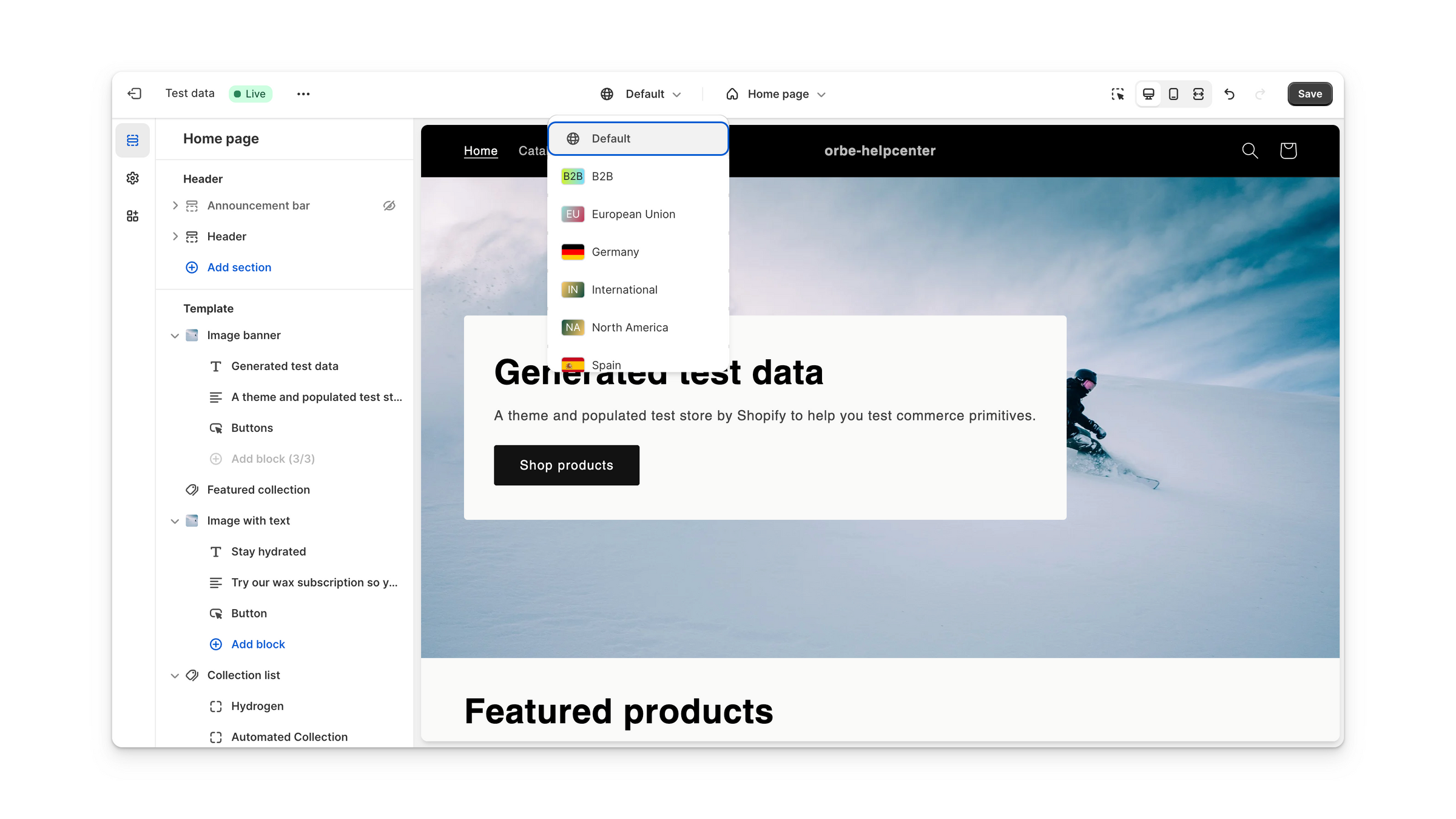
Previously, if a fashion brand sold in both hemispheres within a single Shopify store, it couldn't display winter products in Spain and summer products in Brazil on the homepage simultaneously. This limitation led some brands to choose to open additional stores through Shopify Plus Expansion Stores. However, now, this customization is achievable directly from the Shopify Theme Editor.
Shopify Markets SEO and Domains
Shopify Markets has proven to be highly effective in terms of Search Engine Optimization (SEO), providing brands with the necessary tools to maximize their organic presence in different countries. At Orbe, we highlight three key aspects:
- Domains: Shopify allows brands to choose between using the main domain (mystore.com), a new domain (mystore.co.uk), a subdomain (eu.mystore.com), or subfolders (mystore.com/en-eu). Each approach has its advantages and disadvantages, but from an SEO perspective, the subfolder configuration is particularly effective.
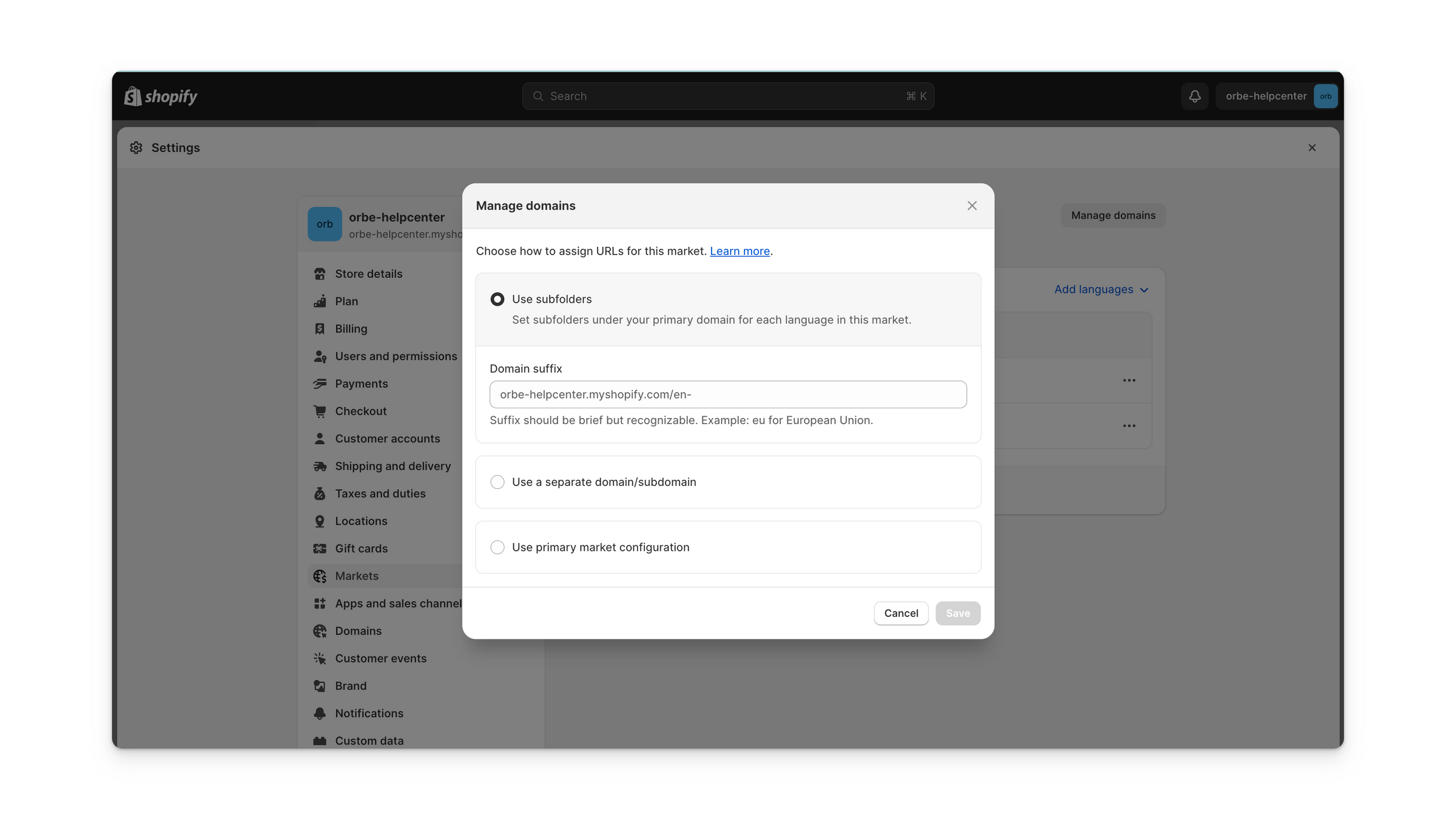
- URL Translation: Before July 2023, Shopify did not allow customizing a URL for different languages. With the update, applications like Translate & Adapt make it easy to translate or modify the URL slug for any product. This means that the same product can be mystore.com/black-shirt and, for Spanish, mystore.com/camiseta-negra.
- Hreflangs: Shopify automatically manages the hreflangs of stores based on the Shopify Markets configuration. Hreflangs are HTML tags that indicate to search engines the relationship between different language or regional versions of a webpage. This functionality helps search engines determine which version of a page to display in search results based on the user's geographical location or language.
In summary, these options, along with other features, make Shopify Markets a set of efficient and optimal tools for positioning various shopping experiences in search engines across different countries.
Shipping, Taxes and Duties
As expected, Shopify offers options to customize shipping methods in each country, as well as to display prices with or without taxes depending on the market. It's worth noting that different countries have different practices, and in many places, it's common to display prices without taxes included on the product detail page. Shopify Markets also makes it easy to manage how taxes are presented in each country. Finally, with Shopify Markets Pro or Global-e, brands can also access advanced options for managing duties, as well as shipping and taxes when selling internationally.
Geolocation
As we explained earlier, Shopify Markets allows you to design shopping experiences for different countries. However, if brands cannot successfully redirect users to the correct experience, they could lose sales.
This is where Orbe can be of great help in increasing your international sales. Our application seamlessly integrates with Shopify Markets to provide advanced geolocation to our customers.
Shopify Markets Limitations
As we've explored the many advantages Shopify Markets provides for brands aiming to boost their international sales, it's important to acknowledge that, despite the numerous advancements and updates since its launch in August 2021, Shopify Markets still has some limitations. While many of these limitations are expected to be addressed in the future, some brands continue to manage multiple stores in Shopify due to these challenges.
Here are some of the current limitations:
- Currency Conversion Fees: Shopify Markets allows users to make purchases in their local currency while brands receive sales in their primary currency, with Shopify charging a fee for currency conversion. This poses challenges for brands selling in multiple currencies, and for such cases, using a Shopify Plus Expansion Store is recommended.
- Dependency on Shopify Payments: While Shopify Markets excels in enabling users to pay in their local currency, its functionality is dependent on Shopify Payments. In countries where Payments is not available, this limitation may lead brands to consider opening a Shopify Plus Expansion Store.
- Legal Entities: Presently, a store can only be linked to one legal entity. For businesses with different entities in various countries, the necessity to open an Expansion store to receive payments under the correct entity may be inevitable.
- Limitation on Regional Markets: Shopify Markets currently only allows markets to be created by countries, limiting the ability to create customized experiences for different regions within the same country. For example, unique experiences for Puerto Rico within the United States or for the Canary Islands within Spain are not possible.
- Stock per Market: While changes are anticipated, currently, connecting different warehouses to different markets is not possible. This can result in logistical challenges, and brands facing such issues are recommended to consider a Shopify Plus Expansion Store to separate markets.
- Taxes and Duties: Despite enabling the creation of localized shopping experiences, Shopify Markets still presents complexities related to shipping, taxes, and customs duties in each country. For comprehensive solutions, Global-e or Shopify Markets Pro offer additional services to navigate this complexity.
- Integrations: As a recently launched platform with a new logic, some applications may not function seamlessly with Shopify Markets. It is anticipated that this will improve over time as the platform matures.
It's essential for brands to carefully weigh these limitations against the benefits Shopify Markets provides and choose the approach that best aligns with their international sales strategy.

